Standards Worldwide
Standards Worldwide
Phone +49 30 58885700-07

Standard [CURRENT]
ASTM C 1576:2025
Standard Test Method for Determination of Slow Crack Growth Parameters of Advanced Ceramics by Constant Stress Flexural Testing (Stress Rupture) at Ambient Temperature
- Publication date
- 2025
- Original language
- English
- Pages
- 16
- Publication date
- 2025
- Original language
- English
- Pages
- 16
- DOI
- https://dx.doi.org/10.1520/C1576-25
Product information on this site:
Quick delivery via download or delivery service
Buy securely with a credit card or pay upon receipt of invoice
All transactions are encrypted
Short description
1.1 This test method covers the determination of slow crack growth (SCG) parameters of advanced ceramics by using a series of constant stress flexural tests in which the times-to-failure of four-point-1/4-point flexure test specimens (see Fig. 1 ) are determined as a function of different levels of constant applied force/stress in a defined test environment at ambient temperatures. This SCG constant stress test is also called a slow crack growth (SCG) stress rupture test. This test method addresses the test equipment, specimen requirements, stress conditions and experimental procedures, data collection and analysis, and reporting requirements. Note 1: The constant stress SCG test method is historically referred to as "static fatigue" testing ( 1- 3 ) 2 in which the term "fatigue" is used interchangeably with the term "slow crack growth." To avoid possible confusion with the "fatigue" phenomenon of a material that occurs exclusively under fluctuating (cyclic) loading, as defined in Terminology E1823 , this test method uses the term "constant stress testing" rather than "static fatigue" testing. 1.3 This flexure geometry test method applies primarily to monolithic advanced ceramics that are macroscopically homogeneous and isotropic in structure and properties with linear elastic stress-strain behavior. Note 2: This test method may also be applied to certain whisker- or particle-reinforced ceramics as well as certain discontinuous fiber-reinforced composite ceramics that are macroscopically homogeneous and isotropic, and exhibit linear elastic behavior. Generally, continuous fiber-reinforced ceramic composites are not macroscopically isotropic and homogeneous, and transition to tough, pseudo-ductile stress-strain behavior. The application of the SCG flexure test method to these materials is not recommended. 1.4 This test method is intended for use at ambient temperatures (typically 15 °C to 30 °C) with various test environments such as ambient and controlled gaseous environments (vacuum, nitrogen, humidified air). The test method can also be used with selected liquids (water, oil) with an immersion test chamber. Note 3: Testing in controlled gas and liquid environments requires an enclosed test chamber to control and maintain the specified environmental conditions. This test method can also be used for cooler (~0 °C to 15 °C) and warmer (~25 °C to 40 °C) temperature testing with a temperature-controlled test chamber. 1.5 Testing for SCG at constant stress at elevated temperatures is addressed in Test Method C1834 . Test Method C1576 on SCG via constant stress is complementary to Test Method C1368 on SCG via constant stress rate . 1.6 The values stated in SI units are to be regarded as the standard and in accordance with IEEE/ASTM SI-10 . 1.7 This test method may involve hazardous materials, operations, and equipment. This standard does not purport to address all of the safety concerns, if any, associated with its use. It is the responsibility of the user of this standard to establish appropriate safety, health, and environmental practices and determine the applicability of regulatory limitations prior to use. 1.8 This international standard was developed in accordance with internationally recognized principles on standardization established in the Decision on Principles for the Development of International Standards, Guides and Recommendations issued by the World Trade Organization Technical Barriers to Trade (TBT) Committee.
ICS
81.060.30
DOI
https://dx.doi.org/10.1520/C1576-25
Also available in
Loading recommended items...
Loading recommended items...
Loading recommended items...
Loading recommended items...
